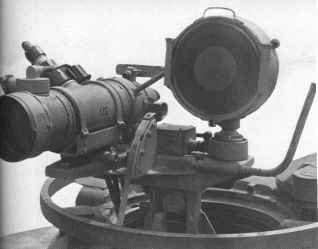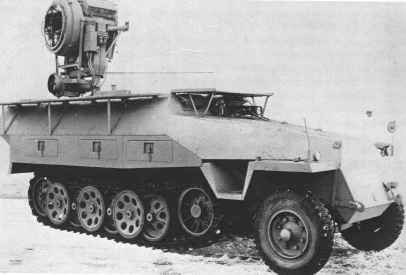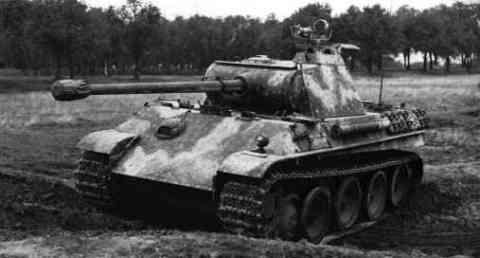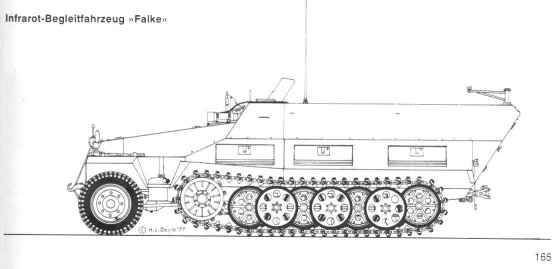Nightfighting Panthers
Some few Panthers
were equipped with special infrared devices for night combat. The
"Heereswaffenamt" WaPrüf 8, in cooperation with the
AEG was dealing with this kind of optical equipment since 1936,
but devolopment was discontinued and the decision to further investigate
in this area wasn´t made until the Allies gained total airsuperiority
in 1943. From now on much energy was invested in the project.
The results of these investigations, which
were lead by Ministerialrat Dr.-Ing. H.Gaertner Heereswaffenamt/WaPrüf
8, were, that in 1943 the Wehrmacht equipped some few Panthers with
200-mm infra-red searchlights FG 1250 and a BIWA (Bildwandler -
image converter), which converted the infra-red image into a visible
reproduction. In the first tests at the armoured forces school at
FALLINGBOSTEL (North Germany) near HANNOVER the crews trained to
drive and to aim at night. Admittedly the searchlight range wasn´t
more than 600 metres, limiting the long range advantage of the excellent
KwK42 75mm/L70.
|

|
|
Detailed
Sketch of the 200mm "FG 1250" infra-red searchlight and
scope
|
|

|

|
|
The FG 1250 infared
searchlight and scope mounted on the commander´s cupola of an
Panther Ausf.G. The steel band was fed through a hole in the
turret roof at the base of the cupola. This steel band, connected
internally to an indicator, allowed the gunner to recognize when
the elevation of the gun was on target. |
Brief
Datalist
|
-
Early 1930s:
Nightvision equipment research began in Germany
-
1934:
AEG unveiled a device named "Braunsche Roehre" in 1934, a
core IR conversion technology
-
1939: a
military prototype of an IR Nightvision device was fitted to a 37mm
Pak-36 and presented before the OKW, but it could not meet the
requirement that it be easily operable and offer similar accuracy for
the weapon as in daytime, so it failed to secure further assistance
from the army.
-
In the fall of 1942,
it was fitted to 75mm Pak-40 for further tests, and produced very
successful test results by middle of 1943.
-
By spring 1944,
some 1000 IR units were supplied but the army officially refused their
usage
-
June 1944:
After D-Day, the Germans could move safely only at night, highlighting
the need for IR equipment. A limited number was issued to the army and
the airforce, a few months later.
-
The Infrared
unit was basically composed of two components: infrared searchlight
(Infrarot-Scheinwerfer) and imaging device (Bildwandler or
"Biwa")
-
The Infra-red
unit was fitted to AT guns, trucks, Marder IIs, few Jagdpanthers, and
most notably Panthers along with Sdkfz 251 operating alongside
-
In early 1945,
Panzerdivision Clausewitz went into action in Fallersleben/Niedersachsen.
It had negligible armor, but two of the Panthers were equipped with IR
device (probably "Sperber").
-
Some
operational account remains for April 21, 1945: Being lead by
Sd.Kfz.234/1 recon vehicles the last 10 of the tanks approched the US
AT position by Weser/Elber canal (76mm AT Gun M-2) First assault
started at 2 AM. The Americans were alerted and flares were launched.
The lead Panther was hit and fell into a ditch. IR Panthers took their
turn, which located the AT guns and fired some 20 rounds, destroying
the pakfront. The opposing artillery men and supporting personnel fled
in panic. IR Panthers went into persuit and destroyed several trucks
and support vehicles. The attack was a success which demonstrated the
tremendous potential of IR technology.
-
Some Panther G
models were fitted with special exhaust pipes to reduce detection. All
IR devices were ordered to be destroyed after a tank was lost. All
devices were connected to stick grenades which were to be detonated by
the last man abandoning.
-
Mid April
1945: More IR Panthers appeared towards the end of the war. Some
were encountered by British armored units: one unit met some IR
Panthers near Uelzen and after a one-sided fight, 1 British platoon of
Comet tanks was annihilated.
-
Special night
tactics were devised at the panzer school in Fallingbostel. 3 IR
Panthers had welded on armored fences on engine decks shielding 3
grenadiers armed with MP44s serving as lookouts and armed with IR
equipped MP44s ("Vampir"). The Panthers are lead by
Sdkfz 251/21 "Falke" boarded by MP44 armed grenadiers.
When attack is feasible, support comes from Sdkfz 251/20 60 cm
"Uhu" IR searchlight.
|
Because of this reason the developers
mounted an even greater 600mm searchlight on a halftrack, the Sd.Kfz.
251/20 "UHU", which was intended to be attached to each
platoon to enhance the night fighting range of the platoon. Finally
the Wehrmacht planned to use a halftrack called FALKE in combination
with the vehicles mentioned. This halftrack was intended to be the
transporter for a Panzer Grenadier Squad, which was equipped with
nightfighting capable Sturmgewehr-44s called VAMPIR. The Wehrmacht
codename for this Kampfgruppe consisting of UHU/FALKE/VAMPIR
was SPERBER and intended for nightfighting at combat ranges up to
2500 metres.
|

|
|
upper picture: 200mm IR searchlight and
scope for driver mounted on Sd.Kfz. 251/20 |
|

|

|
|
Upper
left and right pictures: 600mm searchlight IR device "UHU"
mounted on Sd.Kfz. 251/20 |
Production
History
Starting in September 1944, a limited number of Panthers were to be outfitted with an infrared searchlight and scope mounted on the commander's cupola. The 200 watt screened light, in combination with the infrared receiver/gun sight, had a range of up to 600 meters in clear weather at night. A steel band connected the infrared sight to an internal control for gun elevation.
The following changes were made to a normal Ausf.G to prepare it for mounting the FG 1250 infrared searchlight and scope. A mount was welded on the inner ring for the 12-Uhr-Zeiger that still allowed the free rotation of this ring. A hole for the steel band connecting the infrared scope to the internal elevation control was bored in the turret roof in front of the commander's cupola. An armored guard for this hole was welded to the turret roof. Four base plates for mounting an armored bin were welded on the right side of the hull rear, replacing the Gepaeckkasten (021 St 48399) stowage bin. The stand for the battery and GG 400 electrical generator was mounted inside in the right rear corner of the fighting compartment, replacing the three-round ammunition bin, a section of floor plate and the cover for the rear shock absorber.
Each Panther with an FG 1250 was identified by the letter "F" stamped behind the Fahrgestell Nummer on the serial number plate (not to be confused with the "Panther Ausf.F"). On 7 August 1944, MNH was sent a model of the FG 1250 that was to be installed in the Panther Ausf.G with Fgst.Nr.128520 F. Since it was determined on 8 August 1944 that installation was to be expedited, the model of the FG 1250 was to be mounted in Panther Ausf.G with Fgst.Nr. 128495. On 4 September 1944, MNH reported that, the model of the FG 1250 couldn't be mounted in Fgst.Nr.128495 due to shipping delays, but MNH intended to mount it in Fgst.Nr.128557 (completed on 5 September 1944).
Also, on 7 August 1944, MNH had received directions to install the FG 1250 infrared sighting equipment in accordance with the following schedule: 50 in September, 70 in October, 80 in November, and 100 in December 1944. MNH countered with a proposal to complete all 120 Panther Ausf.G with FG 1250 in October, instead of 50 in September and 70 in October. On 8 August 1944, due to the military situation, OKH rejected the counterproposal and ordered MNH to mount the FG 1250 on the last 50 Panther Ausf.G completed by MNH in September.
On 5 October 1944, MNH reported that due to the delayed arrival of acceptance specifications, only 20 Panthers were produced mounting the FG 1250 in September. However, the shortage of 30 from September were to be completed in October. MNH was then scheduled to complete a total of 80 Panthers with FG 1250 in October.
On 18 November 1944, MNH noted that based on the latest orders from OKH, FG 1250 were not to be mounted on any Panther completed in November. The Panthers already prepared for installation of the FG 1250 were to be converted back to normal Ausf.G. This included re-mounting the Gepaeckkasten stowage bin on the right hull rear, replacing the stand for the GG 400 with the three-round ammunition bin, and removing the mounts for the FG 1250 in the turret, as well as removing the battery and the high voltage transformer. In this same order, MNH was directed to outfit 30 Panthers with FG 1250 in December.
On 13 December 1944, MNH was informed that they were still expected to mount 30 FG 1250 on Panthers in December 1944. Later, MNH was ordered to outfit all of their Panthers with the FG 1250 starting on 15 January 1945.
Nightfighting
Panthers in Action
In summer 1944 the Panthers of
3.Kompanie, 24th Panzerregiment, 116th Panzerdivision, were equipped
with UHU on the battle/excercise-area BERGEN, and actually
trained the use of the nightfighting concept SPERBER. Hitler
planned the mission of this Kompanie to be during the Operation WACHT
AM RHEIN (Battle of the Bulge) and actually some squads were tranfered
to the western front, but never saw action there.
One SPERBER squad including their Panthers was
transfered to STUHLWEISSENBURG (Hungary) in early 1945 with 6th
SS-Panzerarmee, intended to support the german counterattack to
secure the area of Budapest. The rest of the Kompanie followed,
but without nightfighting equipment. In 1945 the Wehrmacht planned
to form 5 SPERBER Kompanies, but this concept proved to be illusory.
2 SPERBER squads joined the spontanuous formed Panzerdivision "CLAUSEWITZ",
which was formed in spring 1945 on the western front. On 21st of
april, these 2 squads ran down an american ambush, which has been
set up at the WESER-ELBE-KANAL, and by this ensured the only documented
action of the nightfighting concept SPERBER.
In march 1945 the Panzerdivision "MÜNCHEBERG"
received one fully equipped Kompanie of 10 SPERBER capable Panthers
and one SPERBER capable Panzer Grenadier Kompanie. The Division
took part in the last fights during the battle of BERLIN. If this
Division used the SPERBER concept isn´t documented.
The armoured forces school at FALLINGBOSTEL
developed an even more mature solution called "LÖSUNG
B - solution B" to make use of the FG 1250 device. Since the
system SPERBER had the critical drawback that only the tankcommander
had nightvision and therefore had to direct the driver and the gunner,
experiments were made with some Panther As and Ds which were equipped
with an infrared-searchlight and image converter for the driver
and a periscope for the gunner. This way 3 crewmembers obtained
nightfighting ability. In April 1945 some of the solution B equiped
Panthers were ordered to the Division "CLAUSEWITZ". In
mid april these Panthers saw their only doctumented action near
UELZEN, where they destroyed a full platoon equipped with the brandnew
british Comet tanks.
Bibliography
Walter J. Spielberger, Hilary L. Doyle "Der
Panzer-Kampfwagen Panther und seine Abarten" Motorbuchverlag 5.
Auflage 1999
S. Hart, R. Hart "Deutsche Panzer im Zweiten
Weltkrieg" Gondrom Verlag 1998
Thomas L. Jentz "Der Panther - Entwicklung,
Ausführungen, Varianten, Charakteristische Merkmale, Kampfwert"
Podzun-Pallas Verlag 1997
Thomas Anderson and Vicent
Wai "ARMOUR AT WAR SERIES 7006 PANTHER" published by
Concord
Last update:
07-04-00
|









